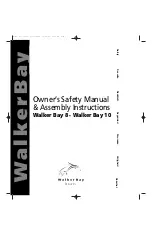
27
SAILING BASICS
Safe and sane guideline for the beginner; and an easy review
for the experienced.
Always wear a life jacket when boating.
BALANCING THE BOAT
When sailing, sit on the upwind side of the boat (wind on your
back) just in front of the tiller, facing the sail. Balance your
weight further outboard as the boat begins to tip or heal over
with the wind in the sails. Tuck one foot under the hiking strap
for balance. Use your hand that is forward to hold and control
the mainsheet. Use your hand that is aft to steer.
STEERING
Steer the boat by pushing the tiller away from you to turn
towards the wind. Pull the tiller towards you to turn away from
the wind. Keep the movement of the tiller to a minimum to
prevent over-steering. This will help you keep the boat moving
in a straight line as you pay attention to other watercraft and
sail adjustments.
SAIL POWER
Face the sail in order to pay close attention to the trim or
adjustment of the sail. When the front of the sail, just behind
the mast, luffs or flutters in the breeze, you lose power. To
start moving, pull the sail in just enough to stop the sail from
luffing. There are also short ribbons hanging on either side of
the sail. Follow the diagram of sail and course adjustments
above using the "tell tails" to get the most performance out of
the sail for all angles of sailing. The tell tails react to air flowing
over the sail and will help you see that the sail is pulled in too
tight or too loosely. If you pull the sail too tight you will stall
the sail power. Ease the sail out until it luffs, then pull it in just
a little until it stops luffing. You will adjust the trim whenever
the wind changes direction or you change course.
Refer to the sail trim diagram below for approximate sail
settings for the different points of sail or directions you will be
sailing. Note the "can't sail zone". You cannot sail in this
direction due to the fact that the sail will luff constantly when
pointed into the wind. If you get stuck in irons (or stop pointed
into the wind) you will need to reverse the rudder and push the
sail forward to back-wind it. The jib should be back winded by
the crew to assist. This will back the boat up. Reverse the
rudders and let the sail out until the boat is positioned more
across the wind (close reach). Then you can correctly trim the
sail and start moving forward.
WIND
COMING
ABOUT
FALLING
OFF
HEADING UP
WIND
CAN'T
SAIL
IN
THIS AREA
Close Hauled
Close Hauled
Close Reach
Close Reach
Medium Reach
Broad Reach
Medium Reach
Broad Reach
Do
wnwind Run
Summary of Contents for 21 Sport Cruiser
Page 1: ......





































